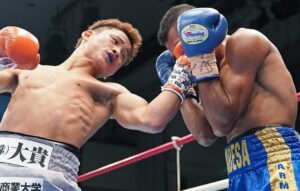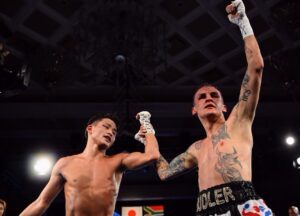Hailing from Izumi, one of Japan’s newer cities locked towards the south of the island, twenty-five year old, Hiroto Kyoguchi (12-0, 9KOs), has already etched his name in the nation’s record books. Capturing his maiden world title after only fifteen months as a professional, it was the shortest span of any Japanese fighter, thus far. The area, which falls into the Kansai region or the Osaka prefecture, had become famous for its cabbage and its wrestlers – an interesting combination.

In recent years, the art of boxing had become a far more prominent arm of Japanese culture. The inclusion of Naoya Inoue within the World Boxing Super Series, the surging, relentless progress of Ken Shiro and of course, one of the youngest three-weight champions in history, Kosei Tanaka, had ensured boxing’s western fans take notice. The little men from the Pacific were savage punchers, fresh-faced and well-mannered.
Emerging from a plethora of traditional martial arts taught in schools and local gyms, Kyoguchi revealed that it wasn’t boxing which first grabbed his attention. Despite fleeting spells with those sports ingrained in Japanese culture, pugilism prevailed, with his typically tough childhood instilling the grit and determination required to succeed. Currently a two-weight world champion himself, he finds himself at an exciting juncture approaching his first defence of his new title.
“In the countryside, this world champion was born for the first time, from Izumi. It is not a prosperous place, but it can be said that it’s a good place to try your heart out. I was talented [as a young] boy. I was doing karate in early childhood.”

“I still have my parents [at home], an older brother and older sister. But I am the only one involved in boxing. I started boxing because I thought that was a world where I can express my existence. I was confident that I could be the best in the world.”
As Kyoguchi awaits his next assignment, a bout with unbeaten Thai challenger Tanawat Nakoon recently announced for June 19th, he explained that his aim was to become the unified, light-flyweight champion in an attempt to promptly follow countrymen Inoue, Shiro and Tanaka into boxing’s spotlight. It was during an interval at Tanaka’s latest bout in March that our smartly-suited subject was presented with the Ring magazine championship, a token treasure with the aim of recognising only one fighter from each division. The belt has been long thought of as a symbol – recognising the best, though some detractors point to its affiliation with Oscar De La Hoya, dampening the claim.
Hiroto’s fight with Hekkie Budler, held in Macau on New Year’s Eve, had edged him further into the mainstream. Stopping the South African had announced him to a wider boxing audience, yet those familiar with the lighter weights had never been in doubt. In beating the ‘Hexecutioner’, he’d managed to topple a multiple-time world champion, remaining relatively comfortably throughout.

His slot on the prestigious December 31st show echoed their appreciation of his ability, with Kyoguchi explaining that it was ‘an honour’ to fight on that card, in particular. Those Asian fight cards held on the last day of the year were traditionally their largest events, sometimes featuring multiple championship fights. Other times scheduling money-spinning, circus acts such as Floyd Mayweather Jr v Tenshin Nasukawa.
He captured the WBA (Super) world title when beating Budler and paid respect to his fallen opponent, “I was very happy! I feel my power going up in everything I do by raising the class of opponents. He [Hekkie Budler] was a very good fighter, but I was confident and I was not surprised. I want to have those unification fights!”
“I think that it will be around summer [when I fight again]. I do not know yet when, but [in future] I’d like to have a fight with all of the other current world champions. But just take a look at my boxing skills, they know I am an exciting fighter!”

With his three-piece suit and thick-rimmed glasses on, he smiled as he paraded the title during his cameo in Gifu City. Only the eighth Ring magazine champion at light-flyweight, he was happy, but not quite yet satisfied. In his mid-twenties, he is seemingly approaching his peak as he hunts the titles that currently elude him.
The work that Hiroto and his team had thrown into his career had not yet fully been repaid. He sent pictures of his gym, showing his stablemates smashing the pads or working the heavy bag. He explained those gruelling, daily requirements and even shed light on the next generation, destined to sweep world titles in multiple divisions.
“I am trained by the best team. My trainer is Mr Inoue. [In training, we have used] mitt-on-drum mitt drills. Sunday is normally our day off, but even then, at 4pm we have about two hours of training. Other than that, we are always in the gym. There are many excellent fighters surrounding me. My successor is Ginziro Shigeoka.”
Shigeoka was one to watch, after finishing an amateur career with a record of 56-1, his only defeat coming at the hands of his own brother. Following in Hiroto’s footsteps and with the support of a bustling, professional gym, it will be fascinating to watch him develop. Japan’s production line shows no sign of stopping.

Although the next generation are already stealthily collecting belts, it was the current crop of champions who had stamped their East Asian dominance on the sport. Combat sports, or martial arts as they’re more commonly referred to in Japan, are encouraged from an early age with children spending hours refining technique.
With Hiroto Kyoguchi, they had produced another devastating fighter spanning multiple weights. He was a quiet character, yet carried confidence perhaps masked by his respectful nature – now becoming a rarity in a sport engulfed in social media tirades. Kyoguchi’s aim was to dominate, much like those champions before him.
“I have to keep winning fights myself to make Japan’s boxing popularity bigger. I want to be a great boxer worldwide. I plan to do it until I’m about thirty-two years old. I think I can be the world champion until I reach flyweight.
“It has become stronger again, [boxing in Japan]. I think that it is the King of world boxing and all of Japan is proud of its fighters. I think boxing is a major sport here [already], so I hope it becomes more common. I think I have to be active for that purpose.”
Interview written by: Craig Scott
Follow Craig on Twitter at: @craigscott209